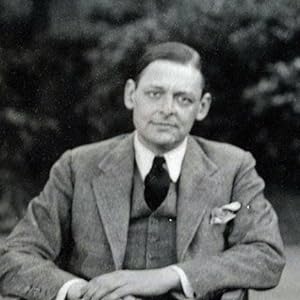

Last month's prompt with all its quotes and allusions to other poets was like
flipping through my copy of The Norton Anthology of Poetry. I played with
that prompt and I did page through that old anthology. T.S. Eliot caught my
attention. he was an important poet for me in my undergraduate days. I loved
the puzzles and allusions in his lines. I like it less today. But his poem
"The Love Song of J. Alfred Prufrock" is still one I love and some lines are
deep in my memory.It was first published in 1915 and later included as the
title poem in his collection Prufrock and Other Observations.
The poem is a dramatic monologue whose speaker relays the anxieties and preoccupations
of his inner life, and his romantic hesitations and regrets. It is considered
one of the defining works of modernism. That literary movement had writers
experimenting with form and plumbing the depths of alienation, isolation,
and the confusion of life at the turn of the 20th century.
Though Eliot’s poem is less about external events and more about inner drama,
rereading it this past week, I saw in my marginalia that I imagined myself
walking with Eliot to a party. December is a month of parties. I saw myself
walking through town to a party where "the women come and go / Talking
of Michelangelo." Sounds like a good literary party.
The poem is a dramatic monologue where middle-aged Prufrock wanders the streets.
The party is just a moment. And it is a moment surrounded by anxieties, indecision,
and fear of rejection. That also fits into some parties I wandered into in
my youth!
Our call for submissions this month is for poems about a party. We can be
going to the party, at the party, leaving or just remembering a party. It's
a story, a narrative, perhaps an inner monologue. But where is the meaning in
this party?
Prufrock wanders through fog, smoke, cheap hotels, restaurants and a party.
(though my notes seem to doubt that there even was a party.) And he is fearful
about his thinning hair, aging body, and inadequacy. He doesn't know if he
even dares to “disturb the universe.” He thinks “there will be time” for decisions,
revisions, and to confess his feelings to a woman. He knows he is “not Prince
Hamlet” but a minor character. Poor J. Alfred. He should have gone to a party
and had some fun. Why is the poem a "love song?"
Read
the entire poem
 Thomas Stearns (T.S.) Eliot was born in 1888 in St. Louis, Missouri, and
became a British subject in 1927. He is the author of the groundbreaking poem,
The Waste Land, the brilliant Four Quartets, and Old
Possum's Book of Practical Cats (which is the basis for the musical
Cats!), along with numerous other poems, prose, and plays.
Thomas Stearns (T.S.) Eliot was born in 1888 in St. Louis, Missouri, and
became a British subject in 1927. He is the author of the groundbreaking poem,
The Waste Land, the brilliant Four Quartets, and Old
Possum's Book of Practical Cats (which is the basis for the musical
Cats!), along with numerous other poems, prose, and plays.
Eliot won the Nobel Prize for Literature in 1948.
T.S. Eliot died in 1965 in London, England, and is buried in Westminster Abbey.
You can browse all his books
on Amazon, and buy his Collected
Poems, but you can also get his
complete works on Kindle for free.
![]() The deadline for submissions for the next issue is December 31, 2025.
Please refer to our submission guidelines
and look at our archive of 26
years of prompts and poems. Follow our
blog for prompts and many topics in poetry.
The deadline for submissions for the next issue is December 31, 2025.
Please refer to our submission guidelines
and look at our archive of 26
years of prompts and poems. Follow our
blog for prompts and many topics in poetry.